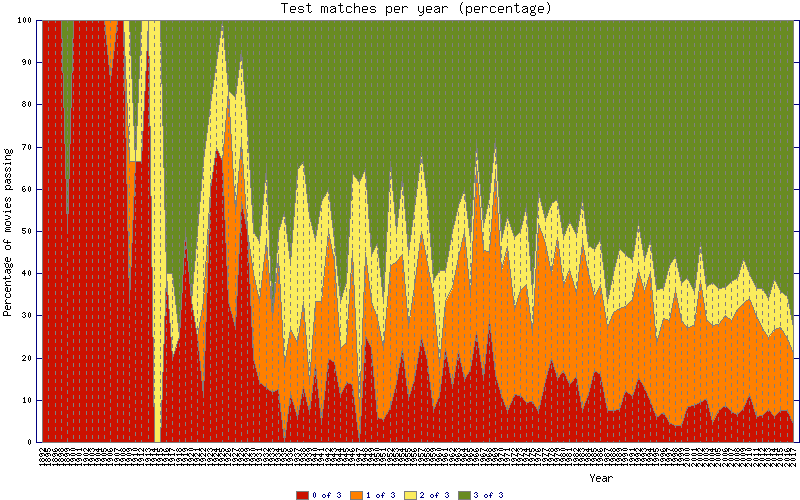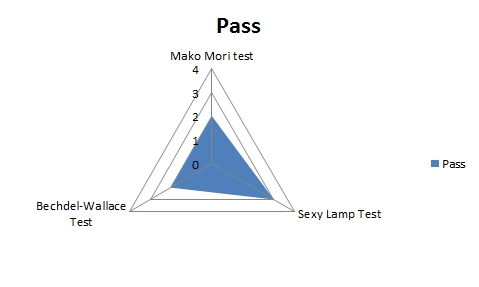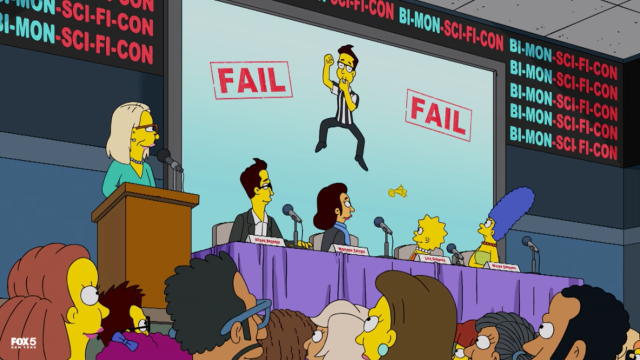In the latest episode of Rick & Morty alternative The Simpsons, guest star Alison Bechdel describes her famous Bechdel test for films: Do two female characters have at least one conversation that’s not about a man? Marge immediately brings up Homer, provoking Bechdel’s FAIL animation, shown here in handy exploitable form:
From last night #TheSimpsons: When it comes to her test, Alison Bechdel isn’t messing around. pic.twitter.com/XZVPlJCrDG
— Tim Long (@mrtimlong) October 9, 2017
Bechdel’s test, popularised in her comic Dykes to Watch Out For, was never intended to wholly define a film as “feminist” or “sexist.” After all, “Baby Got Back” passes it. Bechdel invented the test with her friend Liz Wallace to set a low bar that many Hollywood movies still can’t clear. As her character Mo puts it in the comic, “Last movie I was able to see was Alien.”
Setting that low bar has many valid uses, which is why it’s so popular. For one, as the A.V. Club’s Caroline Siede points out, it raises basic awareness of the massive gender disparity in media: Very few movies would fail a reverse Bechdel test for men.
And it’s a strong measure of female representation across an industry. Multiple organisations keep a running Bechdel scorecard of feature films. One chart of over 7,000 films indicates representation slowly improving since the 70s:

The standard is used in industry revenue analysis (showing that passing films outperform failing ones) and in annual Oscar wrap-ups. It’s the basis of a ratings stamp in some Swedish theatres, and it’s one of many check-box criteria on screenplay database The Black List. But Bechdel’s isn’t the only popular test for media’s portrayal of women.
More Tests of Female Representation
Tumblr user Chaila invented the Mako Mori test after noting that Pacific Rim fails the Bechdel Test despite a strong female character, while Thor passes it. A film passes this test if “1) one female character 2) gets her own narrative arc 3) that is not about supporting a man’s story.” The test is more subjective than Bechdel’s, but of course so is the issue they both address.
Writer Roxane Gay proposed a six-part test: Is there a central female character, with supporting female characters, who doesn’t compromise herself for love or live extravagantly for no explained reason? And at least half the time, is this character a woman of colour, transgender, and/or queer? Gay’s sixth point is a non-requirement: Female characters “shouldn’t have to live up to an unrealistic feminist standard.” They can be flawed, so long as they feel like real human beings.
The satirical Sexy Lamp test by comics writer Kelly Sue DeConnick (co-creator of Pretty Deadly and Bitch Planet) is the easiest to pass: If your female character could be replaced by a sexy lamp without the plot falling apart, “YOU’RE A FUCKING HACK.” Naturally, many movies fail it. Especially if, as Tumblr user shitifindon suggested, you’re allowed to stick a Post-It on the sexy lamp.
The Crystal Gems test, designed by critic Locuas and named after the cartoon heroes in Steven Universe, combines the three above tests, and adds a scale for each — because we deserve to raise our standards. An example of its tridimensional results:

The Ellen Willis test requires the story (or pop song) to make sense if the genders were flipped. (It’s meant, of course, to call out gender roles, not biological factors.)
Editor and fandom expert Jenn Northington’s Tauriel test just asks that in a given work, at least one woman be good at what she does.
Other Media Tests
But hey, women are only one of a beautifully wide range of people poorly represented in media! So there are tests for other marginalized groups as well. Some of the best:
The racial Bechdel test has the same simple rules as the Bechdel Test, applied to people of colour: At least two of them must have a conversation that’s not about a white person. (The native Bechdel test applies a stricter version, to show that movies and shows with Native American characters still often fail.)
Similarly, actor Dylan Marron’s YouTube series Every Single Word features brief compilations of every line delivered by people of colour in a given well-known film. Of the 34 compilations, only five are longer than a minute.
The Deggans rule (by TV critic Eric Deggans) requires a show that’s not about race to include at least two non-white human characters in the main cast.
The Morales rule, by actor Natalie Morales, asks that no one calls anybody Papi, dances to salsa music, or uses “gratuitious Spanish.”
The DuVernay test, proposed by film critic Manohla Dargis in honour of director Ava DuVernay, is more abstract. A work passes it if “African Americans and other minorities have fully realised lives rather than serve as scenery in white stories.”
GLAAD’s Vito Russo test has three requirements: The film must contain a lesbian, gay, bi, or transgender character. That character must not be predominantly defined by their orientation or gender identity — they need to be as unique as straight cis characters. And they must be important enough to affect the plot — they can’t just crack some jokes or “paint urban authenticity.”
The Topside test for trans literature, created by literary editors Riley MacLeod (now at Kotaku) and Tom Leger, asks that a book include multiple trans characters who know each other, who talk to each other about something other than medical transition procedures. The goal is to set a higher bar than, say, Jeffrey Eugenides’s Middlesex, which use trans characters as a prop for non-trans characters. (The link includes some recommended texts.)
For more media tests, like the Finkbeiner test for non-fiction and the Lauredhel test for toys, check out this list on the Geek Feminism Wiki. Remember, no one test can replace a qualitative examination of a film. Not all of them are even recommended in earnest. But each test opens up critical discussion, challenges and inspires creators, and provides another tool for measuring the industry.

Comments
One response to “The Bechdel Test, And Other Media Representation Tests, Explained”